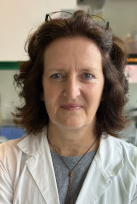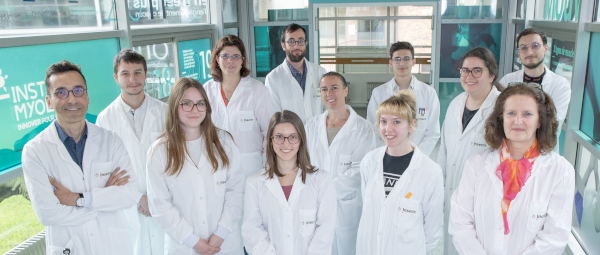 Head: Geneviève Gourdon
Head: Geneviève Gourdon
Several years ago, we created a transgenic mouse model (DMSXL) carrying very large human genomic sequences containing the DMPK gene and the largest CTG repeat introduced in mice so far (>1500CTG). These mice show a very high level of CTG repeat instability and reproduce molecular and physiological feature of DM1.
Our research follows 3 axes:
. Mechanisms involved in trinucleotide repeat instability from mouse & cell models to DM1 families
. Molecular and physio-pathological consequences of CTG repeat expansions behind the neuropsychological impairment and brain abnormalities and involved in the congenital form of the disease
. Preclinical testing in DM1 mice muscle & brain molecular and physiological phenotypes

Group members
Geneviève GOURDON, PhD, DR-Inserm, Group leader
Mario GOMES-PEREIRA, PhD, DR-Inserm
Stéphanie TOME, PhD, CR-Inserm
Aline HUGUET-LACHON IE-University
Alexandre GARDIOL, IE-Inserm
Grégoire HAOUY, Post-Doc
Gabriele ORDAZZO, Post-Doc
Paul MAGNERON, PhD student
Pauline MEGALLI, PhD student
Louison DAUSSY, PhD student
Valeria GORBUNOVA, Master 2
Contact : genevieve.gourdon@inserm.fr
Our last publications
- Muscle-specific gene editing improves molecular and phenotypic defects in a mouse model of myotonic dystrophy type 1. Izzo M, Battistini J, Golini E, Voellenkle C, Provenzano C, Orsini T, Strimpakos G, Scavizzi F, Raspa M, Baci D, Frolova S, Tastsoglou S, Zaccagnini G, Garcia-Manteiga JM, Gourdon G, Mandillo S, Cardinali B, Martelli F, Falcone G. Clin Transl Med. 2025 Feb;15(2):e70227. doi: 10.1002/ctm2.70227. PMID: 39956955
- Calcium handling abnormalities increase arrhythmia susceptibility in DMSXL myotonic dystrophy type 1 mice. Cupelli M, Ginjupalli VKM, Reisqs JB, Sleiman Y, El-Sherif N, Gourdon G, Puymirat J, Chahine M, Boutjdir M. Biomed Pharmacother. 2024 Nov;180:117562. doi:10.1016/j.biopha.2024.117562. Epub 2024 Oct 17. PMID: 39423753
- Electrophysiological basis of cardiac arrhythmia in a mouse model of myotonic dystrophy type 1. Ginjupalli VKM, Cupelli M, Reisqs JB, Sleiman Y, El-Sherif N, Gourdon G, Puymirat J, Chahine M, Boutjdir M. Front Physiol. 2023 Sep 21;14:1257682. doi: 10.3389/fphys.2023.1257682. eCollection 2023. PMID: 37811496
- Therapeutic Targeting of the GSK3β-CUGBP1 Pathway in Myotonic Dystrophy. Lutz M, Levanti M, Karns R, Gourdon G, Lindquist D, Timchenko NA, Timchenko L. Int J Mol Sci. 2023 Jun 26;24(13):10650. doi: 10.3390/ijms241310650. PMID: 37445828
- Excessive rest time during active phase is reliably detected in a mouse model of myotonic dystrophy type 1 using home cage monitoring. Golini E, Rigamonti M, Raspa M, Scavizzi F, Falcone G, Gourdon G, Mandillo S. Front Behavioral Neuroscience. 2023 Mar 2;17:1130055. doi: 10.3389/fnbeh.2023.1130055. eCollection 2023. PMID: 36935893
- Periostin as a blood biomarker of muscle cell fibrosis, cardiomyopathy and disease severity in myotonic dystrophy type 1. Nguyen CDL, Jimenez-Moreno AC, Merker M, Bowers CJ, Nikolenko N, Hentschel A, Müntefering T, Isham A, Ruck T, Vorgerd M, Dobelmann V, Gourdon G, Schara-Schmidt U, Gangfuss A, Schröder C, Sickmann A, Gross C, Gorman G, Stenzel W, Kollipara L, Hathazi D, Spendiff S, Gagnon C, Preusse C, Duchesne E, Lochmüller H, Roos A. Journal of Neurology. 2023 Mar 9. doi: 10.1007/s00415-023-11633-1. PMID: 36892629
- [Nanopore and telomeres]. Tomé S. Med Sci (Paris). 2023 Nov;39 Hors série n° 1:64. doi: 10.1051/medsci/2023141. Epub 2023 Nov 17. PMID: 37975773 French. No abstract available.
- Electrophysiological basis of cardiac arrhythmia in a mouse model of myotonic dystrophy type 1. Ginjupalli VKM, Cupelli M, Reisqs JB, Sleiman Y, El-Sherif N, Gourdon G, Puymirat J, Chahine M, Boutjdir M. Front Physiol. 2023 Sep 21;14:1257682. doi: 10.3389/fphys.2023.1257682. eCollection 2023. PMID: 37811496
- Therapeutic Targeting of the GSK3β-CUGBP1 Pathway in Myotonic Dystrophy. Lutz M, Levanti M, Karns R, Gourdon G, Lindquist D, Timchenko NA, Timchenko L. Int J Mol Sci. 2023 Jun 26;24(13):10650. doi: 10.3390/ijms241310650. PMID: 37445828
- Excessive rest time during active phase is reliably detected in a mouse model of myotonic dystrophy type 1 using home cage monitoring. Golini E, Rigamonti M, Raspa M, Scavizzi F, Falcone G, Gourdon G, Mandillo S. Front Behav Neurosci. 2023 Mar 2;17:1130055. doi: 10.3389/fnbeh.2023.1130055. eCollection 2023. PMID: 36935893.
- Periostin as a blood biomarker of muscle cell fibrosis, cardiomyopathy and disease severity in myotonic dystrophy type 1. Nguyen CDL, Jimenez-Moreno AC, Merker M, Bowers CJ, Nikolenko N, Hentschel A, Müntefering T, Isham A, Ruck T, Vorgerd M, Dobelmann V, Gourdon G, Schara-Schmidt U, Gangfuss A, Schröder C, Sickmann A, Gross C, Gorman G, Stenzel W, Kollipara L, Hathazi D, Spendiff S, Gagnon C, Preusse C, Duchesne E, Lochmüller H, Roos A. J Neurol. 2023 Jun;270(6):3138-3158. doi: 10.1007/s00415-023-11633-1. Epub 2023 Mar 9. PMID: 36892629
- MBNL-dependent impaired development within the neuromuscular system in myotonic dystrophy type 1. Tahraoui-Bories J, Mérien A, González-Barriga A, Lainé J, Leteur C, Polvèche H, Carteron A, De Lamotte JD, Nicoleau C, Polentes J, Jarrige M, Gomes-Pereira M, Ventre E, Poydenot P, Furling D, Schaeffer L, Legay C, Martinat C. Neuropathol Appl Neurobiol. 2023 Feb;49(1):e12876. doi: 10.1111/nan.12876. PMID: 36575942.

